Alan Wake 2
Alan Wake 2 was launched in October of 2023 and runs on the Northlight Engine. The game features high-quality assets, volumetric fog, animated foliage, advanced volumetric lighting, high-detail character models, and dense foliage. It also features full Ray Tracing and Path Tracing options that can be enabled with ray-traced reflections and shadows, along with DLSS Ray Reconstruction. It also supports RTX Mega Geometry, DLSS, and FSR Upscaling and Frame Generation. For our testing, we are going to use the in-game graphics preset options for the main quality option, as well as the Ray Tracing preset as needed. Our testing scenario is a manual run-through in the INITIATION 5 – ROOM 665 map.
Native Resolution
The first graph below is at the “High” quality preset, the second graph is at the “Medium” quality preset, and the third graph is at the “Low” quality preset at 1080p.
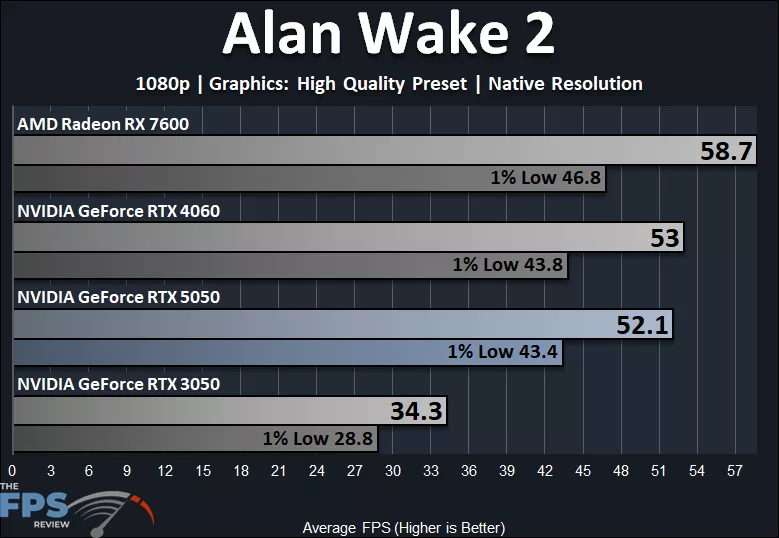
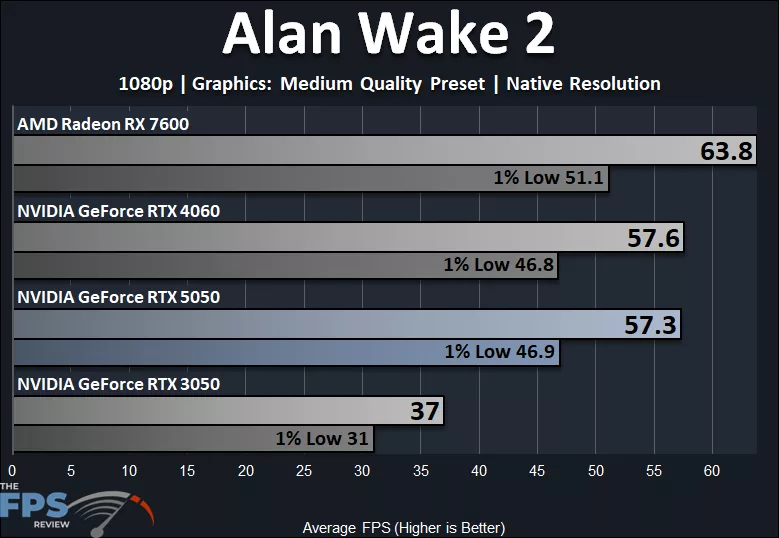
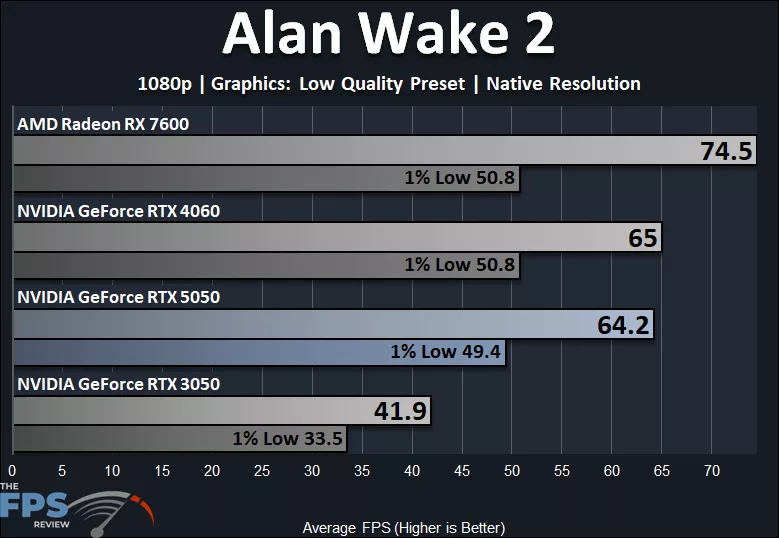
At the “High” quality preset at 1080p, the GeForce RTX 5050 averages 52FPS with a 1% Low of 43.4FPS, this is borderline playable, but certainly not extreme FPS at native resolution. The GeForce RTX 5050 is very close to GeForce RTX 4060 performance here, only a 2% difference, with the 1% Lows being the same. We can see that the GeForce RTX 5050 is a pretty big 52% faster than the GeForce RTX 3050, showing the two-generation performance uplift. In this game, though, the Radeon RX 7600 is actually faster than the GeForce RTX 5050 by 13% and offers up 8% higher 1% Lows.
Dropping down to the “Medium” preset on the GeForce RTX 5050 puts it into a more playable category, averaging 57FPS with 1% Lows around 46FPS. The GeForce RTX 5050 matches the GeForce RTX 4060 in performance. The GeForce RTX 5050 is 55% faster than the GeForce RTX 3050. The AMD Radeon RX 7600 is still faster than the GeForce RTX 5050 by 11%.
Finally, it takes us going all the way down to “Low” settings to make the GeForce RTX 5050 hit above 60FPS on average at 1080p in this game. It is still close to the GeForce RTX 4060. The GeForce RTX 5050 is 53% faster than the GeForce RTX 3050. The Radeon RX 7600 is 16% faster on the average framerate; however, the 1% Lows match the GeForce RTX 5050, so the Radeon RX 7600 is experiencing some low-framerate issues similar to the other 8GB video cards, even at “Low” in this game.
DLSS Upscaling
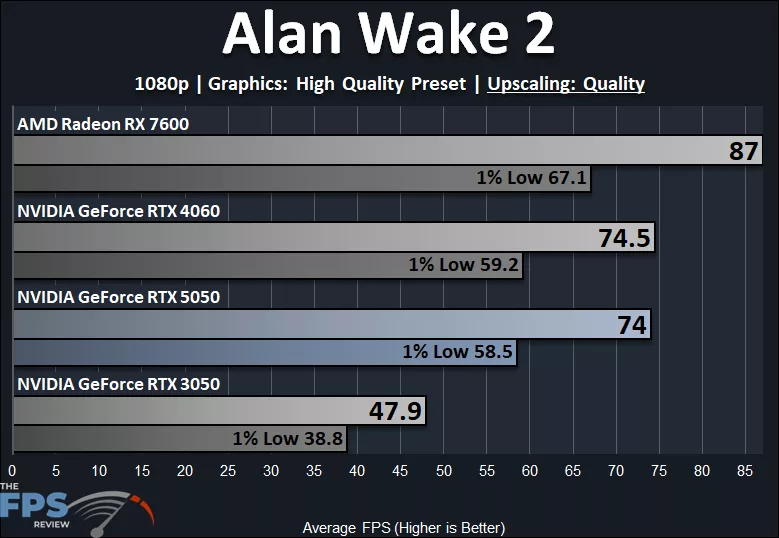
Running on the “High” quality setting in this game, we enabled DLSS Upscaling at Quality mode, and FSR at Quality mode on the 7600. We can see that with DLSS Upscaling enabled, the GeForce RTX 5050 is playable at 1080p on “High” quality, averaging 74FPS, and the 1% Lows are near 60FPS. The GeForce RTX 5050 is on par with the GeForce RTX 4060 in performance. The GeForce RTX 5050 is 54% faster than the GeForce RTX 3050. The Radeon RX 7600 is 18% faster than the GeForce RTX 5050.
Ray Tracing w/ DLSS Upscaling
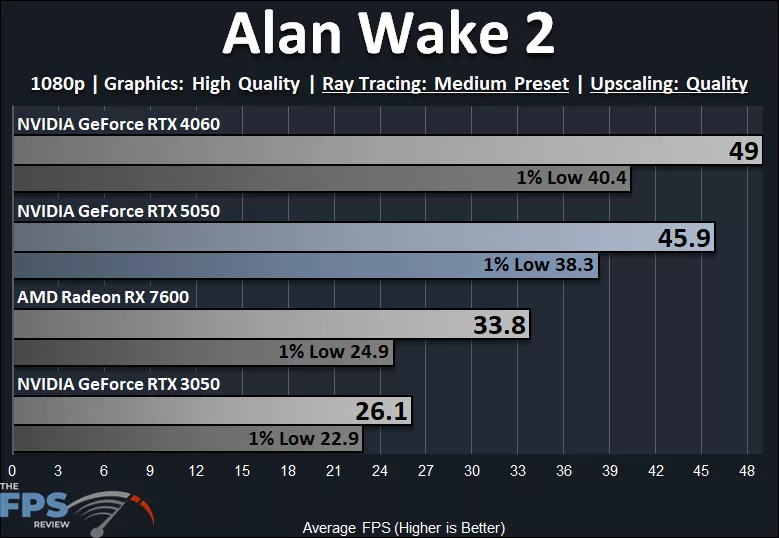
In this graph above, we have enabled the “Medium” Preset Ray Tracing option in the game, and are at “High” quality graphics preset at 1080p, and DLSS Upscaling is enabled. This is not a playable situation at 46FPS average and 1% Lows at 38FPS. The GeForce RTX 5050 is 76% faster than the GeForce RTX 3050, however, showing that there have been RT improvements since the GeForce RTX 30 Series, since RT is a higher percentage faster than Raster performance. The GeForce RTX 5050 is 36% faster than the Radeon RX 7600. The GeForce RTX 5050 is slower than the GeForce RTX 4060 by 6%.
